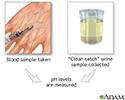Urine pH test
pH - urine
A urine pH test measures the level of acid in urine.
How the Test is Performed
After you provide a urine sample, it is tested right away. The health care provider uses a dipstick made with a color-sensitive pad. The color on the dipstick tells the provider the level of acid in your urine.
How to Prepare for the Test
Your provider may tell you to stop taking certain medicines that can affect the results of the test. These may include:
- Acetazolamide
- Ammonium chloride
- Methenamine mandelate
- Potassium citrate
- Sodium bicarbonate
- Thiazide diuretic
DO NOT stop taking any medicine before talking to your provider.
Eat a normal, balanced diet for several days before the test. Note that:
- A diet high in fruits, vegetables, or non-cheese dairy products can increase your urine pH.
- A diet high in fish, meat products, or cheese can decrease your urine pH.
How the Test will Feel
The test involves only normal urination. There is no discomfort.
Why the Test is Performed
Your provider may order this test to check for changes in your urine acid levels. It may be done to see if you:
- Are at risk of kidney stones. Different types of stones can form depending on how acidic your urine is.
- Have a metabolic condition, such as renal tubular acidosis.
- Need to take certain medicines to treat urinary tract infections. Some medicines are more effective when urine is acidic or non-acidic (alkaline).
Normal Results
The normal values range from pH 4.6 to 8.0.
The examples above are common measurements for results of these tests. Normal value ranges may vary slightly among different laboratories. Some labs use different measurements or test different samples. Talk to your provider about the meaning of your specific test results.
What Abnormal Results Mean
A high urine pH may be due to:
- Kidneys that do not properly remove acids (renal tubular acidosis)
- Kidney failure
- Stomach pumping (gastric suction to remove fluid from the stomach)
- Urinary tract infection
- Vomiting
A low urine pH may be due to:
- Diabetic ketoacidosis
- Diarrhea
- Too much acid in the body fluids (metabolic acidosis), such as diabetic ketoacidosis
- Starvation
Risks
There are no risks with this test.
References
Bushinsky DA. Kidney stones. In: Melmed S, Auchus RJ, Goldfine AB, Koenig RJ, Rosen CJ, eds. Williams Textbook of Endocrinology. 14th ed. Philadelphia, PA: Elsevier; 2020:chap 32.
Fogazzi GB, Garigali G. Urinalysis. In: Feehally J, Floege J, Tonelli M, Johnson RJ, eds. Comprehensive Clinical Nephrology. 6th ed. Philadelphia, PA: Elsevier; 2019:chap 4.
Hamm LL, DuBose TD. Disorders of acid-bace balance. In: Yu ASL, Chertow GM, Luyckx VA, Marsden PA, Skorecki K, Taal MW, eds. Brenner and Rector's The Kidney. 11th ed. Philadelphia, PA: Elsevier; 2020:chap 16.
Riley RS, McPherson RA. Basic examination of urine. In: McPherson RA, Pincus MR, eds. Henry's Clinical Diagnosis and Management by Laboratory Methods. 24th ed. Philadelphia, PA: Elsevier; 2022:chap 29.
Female urinary tract - illustration
Female urinary tract
illustration
PH urine test - illustration
PH urine test
illustration
Male urinary tract - illustration
Male urinary tract
illustration
Review Date: 7/19/2021
Reviewed By: David C. Dugdale, III, MD, Professor of Medicine, Division of General Medicine, Department of Medicine, University of Washington School of Medicine. Also reviewed by David Zieve, MD, MHA, Medical Director, Brenda Conaway, Editorial Director, and the A.D.A.M. Editorial team.







